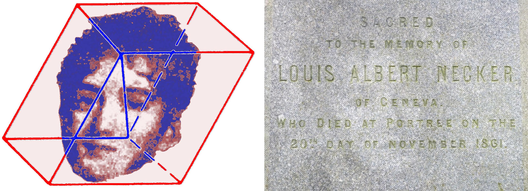Louis Albert Necker1786–1861
Necker was a crystallographer who was startled by the oscillating apparent depth seen in engravings of crystals. He reported this in a letter: “The object I have now to call your attention to, is an observation... which has often occurred to me while examining figures and engraved plates of crystalline forms: I mean a sudden and involuntary change in apparent position of a crystal or solid represented in an engraved figure”. The figure is now typically drawn as a cube, without the connecting transversal, and it is called the Necker cube. Wheatstone, in fact, first described the reversals that occur with a skeleton three-dimensional cube rather than a drawing. Not only did he observe that reversals occur with solid figures, but he also commented on the changes of shape that accompany the reversals in depth. Necker suggested that the alternations were a consequence of involuntary changes in accommodation. While Necker’s simple figure is known to many, few are aware that Necker was also a keen mountaineer and lover of Scotland. He remarked: “Edinburgh is not unworthy of the titles Athens of the North, and the Capital of Mind, which many modern authors have bestowed upon it”. He spent about half of his adult life in Scotland and was buried in Portree on the Isle of Skye. Louis Albert Necker de Saussure (to give his full name) was born in Geneva into a distinguished family, the origins of which were in Ireland. His maternal grandfather was Horace Bénédict de Saussure, alpine explorer and scientist, and the third man to reach the summit of Mont Blanc in 1787. Necker’s father, Jacques Necker, was Professor of Botany at Geneva University, and he had several other famous relatives. Members of the family are mentioned in Galton’s Hereditary Genius. As a teenager Necker (like many Europeans) was fascinated by the Ossianic legends (which had been made famous by the embellished English translations of James Macpherson in the1760s), and learned some Gaelic. He studied geology in Geneva and then went to Edinburgh University in 1806, where he studied chemistry. He enrolled in the classes of Robert Jamieson, and contributed to discussions at the Royal Society of Edinburgh and the Wernerian Society. He became friendly with many figures of the Scottish Enlightenment. At that time he toured Scotland, studying its geology, and produced the first geological map of Scotland. With characteristic delay, his Travels in Scotland and A Voyage to the Hebrides or Western Isles of Scotland were published over a decade later. In 1810 he became Professor of Natural Philosophy in Geneva, and published many papers on a wide range of scientific subjects. The winter of 1839-40 was spent in Portree, where he completed his major work on European geomorphology Etudes Geologiques dans les Alpes. He settled permanently in Portree in April 1841, taking lodgings with the Cameron family in Bosville Terrace. Necker was a Calvinist, and was happy to stay with a Free Church family. His interests turned to astronomy, in particular the Aurora Borealis. He went climbing with the glaciologist James Forbes, who visited him in Skye in 1843 and 1845, when they jointly made the first accurate map of the Cuillins. Forbes visited Necker again in 1848, but commented that he was socially isolated and dwelling on the past. When he died he was buried by the Cameron family next to their plot in Portree churchyard. Necker is shown on the left in his eponymous cube as well as being partially buried in his gravestone on the right.
